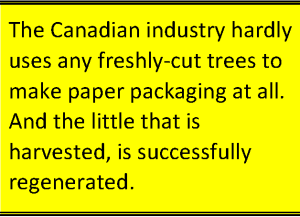Vancouver-based environmental group Canopy continues to make embarrassing boo-boos about paper packaging in Canada. In a blog entitled “What’s in the Box? Canopy answers its own question with a bald-faced lie, giving the impression that paper boxes are mostly made from virgin market pulp.

This is not true. It is certainly not true in Canada. Very little virgin pulp is used by Canadian mills to make boxes in Canada. In fact, most are made from 100% recycled content board that’s been collected from the back of Canadian factories and supermarkets, from offices, or from Blue Boxes and depots. The industry’s environmental council (PPEC) pioneered the further recycling of old boxboard in North America way back in the 1990s. And almost every Canadian (96%) can put paper boxes out for recycling today.
While it is true that some virgin pulp is exported from Canada, it mainly goes into the production of printing and writing, sanitary and specialty papers. Only a small portion of it (15%) ends up in packaging products. So yes, it is both possible, and likely, that some of this exported pulp is shipped back to Canada as packaging with a product inside.
But to imply that virgin pulp represents the prime component of the Canadian industry’s feedstock for boxes, when most of it is 100% recycled content, is a gross distortion of fact.
Canopy also claims that many companies currently don’t know the fibre sources of their paper packaging. There is no excuse for this in Canada. Every single mill member of PPEC has independent third-party chain-of-custody certification of where its original fibre (whether virgin or recycled) comes from. All customers need to do is ask.
